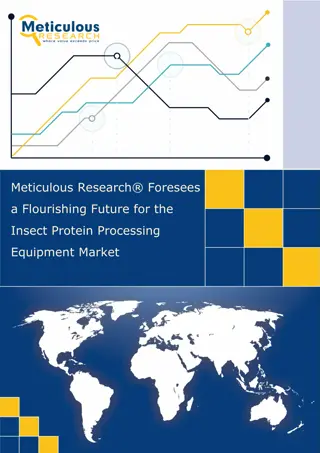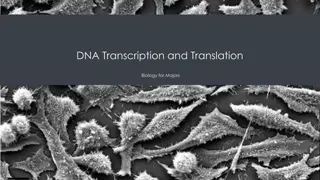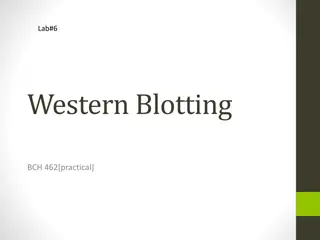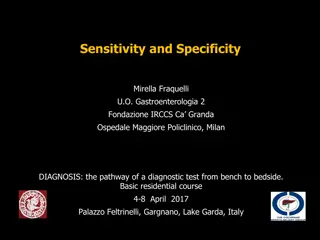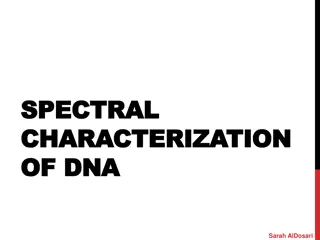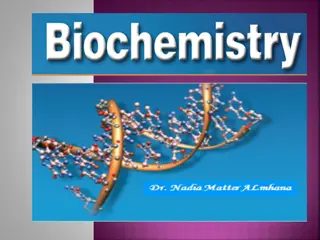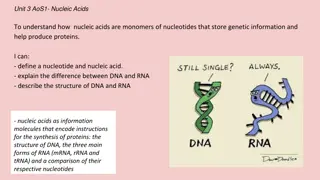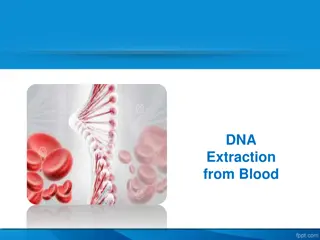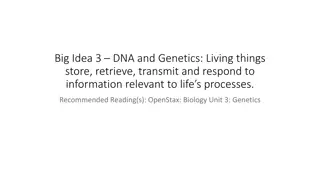Understanding the Relationship Between DNA and Protein Specificity
The relationship between an organism's DNA and protein specificity is intricate. DNA encodes the information for the sequence of amino acids in proteins, thereby determining their specificity. This process involves DNA directing the synthesis of specific RNA molecules, which are then translated into proteins with unique structures and functions. Additionally, the synthesis of proteins occurs in the cytoplasm. Through decoding the mRNA and amino acid sequences, we can gain insights into how DNA influences protein specificity.
Download Presentation

Please find below an Image/Link to download the presentation.
The content on the website is provided AS IS for your information and personal use only. It may not be sold, licensed, or shared on other websites without obtaining consent from the author. Download presentation by click this link. If you encounter any issues during the download, it is possible that the publisher has removed the file from their server.
E N D
Presentation Transcript
WHAT IS THE RELATIONSHIP BETWEEN AN ORGANISM S DNA AND PROTEIN SPECIFICITY? a. a. DNA becomes a specific part of the protein DNA becomes a specific part of the protein structure structure b. b. DNA determines the ribosomal RNA sequence DNA determines the ribosomal RNA sequence that becomes part of the protein structure that becomes part of the protein structure c. c. DNA determines which RNA molecules are DNA determines which RNA molecules are incorporated into protein molecules incorporated into protein molecules d. d. DNA determines the amino acid sequence of each DNA determines the amino acid sequence of each protein. protein.
THE SYNTHESIS OF STRUCTURE X OCCURRED IN THE: a. a. Nucleus Nucleus b. b. Cytoplasm Cytoplasm c. c. Lysosome Lysosome d. d. Vacuole Vacuole
HTTPS://WWW.YOUTUBE.COM/WATCH?V=DG8 3D4VZILK What is something you noticed about the What is something you noticed about the video clip? video clip? What do you think is going to happen What do you think is going to happen next? next?
HTTPS://WWW.YOUTUBE.COM/WATCH?V=ZNNJ WC_5RLI What did you notice happen in this video What did you notice happen in this video clip? clip? What do you think could happen to Peter What do you think could happen to Peter Parker? Parker?
HTTPS://WWW.YOUTUBE.COM/WATCH?V=HM4 BXQEN6SM What happened in this video clip? What happened in this video clip? What is 1 word you can use to What is 1 word you can use to describe what happened to Peter describe what happened to Peter Parker? Parker?
1. 1.Figure out the mRNA and Figure out the mRNA and amino acid sequence for amino acid sequence for the original strand the original strand
1. 1.Figure out the mRNA and Figure out the mRNA and amino acid sequence for amino acid sequence for the original strand the original strand 2. 2.Repeat this for #1 Repeat this for #1- -#4. #4.
AUG AUA GCU UAA Met.-Ile.-Ala.-stop 1. 1.Figure out the mRNA and Figure out the mRNA and amino acid sequence for amino acid sequence for the original strand the original strand AUG AUA CCU UAA Met.-Ile.-Pro.-stop AUG AUA GCC UAA Met.-Ile.-Ala.-stop 2. 2.Repeat this for #1 Repeat this for #1- -#4. #4. 3. 3.Compare the mRNA and Compare the mRNA and amino acid sequence of amino acid sequence of #1 #1- -#4 to the original #4 to the original strand and write down strand and write down what you notice! what you notice! AUG UAU AGC CUA A Met.- Tyr.-Ser.-Leu. AUG AUA CUU AA Met.-Ile.-Leu.-
DNA MUTATIONS: Mutation Mutation - - Change in a DNA sequence Change in a DNA sequence that affects genetic information; that affects genetic information; error or mistake in copying DNA. error or mistake in copying DNA.
TYPES OF MUTATIONS: 1. Point Mutations 1. Point Mutations - - Mutation that affects a single Mutation that affects a single nucleotide, usually by substituting one nucleotide for nucleotide, usually by substituting one nucleotide for another. another. Substitution one base is changed to another Original: AUGUAC C Met Tyr Mutated: AUGUAG Met Stop (causes the amino acid chain to stop protein production early) (causes the amino acid chain to stop protein production early) SILENT Point mutations would NOT change the protein
TYPES OF MUTATIONS: 2. 2. Frameshift Frameshift Mutations frame of the genetic message by inserting or deleting a frame of the genetic message by inserting or deleting a nucleotide. nucleotide. Insertions A base is inserted into the DNA sequence. Deletions - A base is removed from the DNA sequence. Mutations - - Mutation that shifts the reading Mutation that shifts the reading Original: The fat cat ate the wee rat. Original: The fat cat ate the wee rat. Frame Shift: The fat Frame Shift: The fat caa (Frame shift mutations affect all subsequent amino acids!) (Frame shift mutations affect all subsequent amino acids!) caa tet tet hew hew eer eer at. at.
SIGNIFICANCE OF MUTATIONS: Many mutations have little or no effect on the Many mutations have little or no effect on the expression of genes. expression of genes. Mutations may be harmful and may be the cause of Mutations may be harmful and may be the cause of many genetic disorders and cancer. many genetic disorders and cancer. Source of genetic variability in a species (may be Source of genetic variability in a species (may be highly beneficial). highly beneficial).
WHAT VARIES IN OUR DNA: Mutations cause a change in the sequence of the Mutations cause a change in the sequence of the nitrogen bases (or the order of nucleotides). nitrogen bases (or the order of nucleotides). This creates differences between organisms (physical or This creates differences between organisms (physical or not) because the DNA sequences are not similar, so the not) because the DNA sequences are not similar, so the genes do not code for the same traits! genes do not code for the same traits! GENE: GENE: AAGCCTAGCAC = AAGCCTAGCAC = MUTATED GENE: MUTATED GENE: AAGCTTAGCAC = AAGCTTAGCAC = no fingerprint! no fingerprint!




